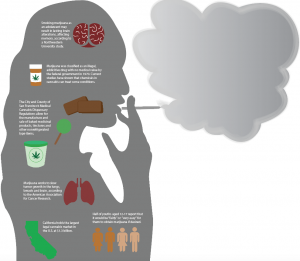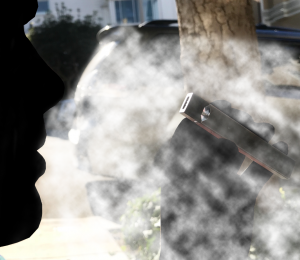Pot legalization increases access for minors
February 9, 2018
The Jan. 1 legalization of recreational marijuana in California is already leading to an increase of teenagers using the drug, with teenagers claiming marijuana is more easily accessible for a casual smoke on the weekend, getting high at parties or skipping class to vape during the school day.
Seventy-seven percent of teenagers in the United States, ages 12 to 17, say that smoking marijuana is safe and a socially acceptable behavior, according to a 2015 Behavioral Health Barometer study.
“I know this is no excuse, but I feel like since it’s so accessible, and everyone around me smokes, it’s OK to use [marijuana] once in awhile,” a 16-year-old San Francisco private school student said. “Using marijuana helps me to destress, deal with anxiety and fall asleep.”
But using marijuana is not without risks and dangers. THC, the chemical within marijuana, crosses the blood brain barrier and can cause an 8-point decrease in IQ for persistent marijuana smokers and change the function and structure of the adolescent brain which develops until the mid-20s, according to Alyssa Bennett, an adolescent medicine physician at Connecticut Children’s Medical Center.
“In terms of marijuana’s effect on memory, there is evidence that smoking marijuana can affect one’s ability to form new memories appropriately for 24 to 48 hours after learning something,” Bennett said by phone.
Adolescents often use marijuana to self-medicate for other problems they experience such as depression, childhood trauma and anxiety, as it can suppresses these emotions according to Bennett. Chronic use of marijuana can make teenagers become dependent on the drug and smoke more regularly in order to feel the initial relief.
“When I’m in a really bad mood and just need to laugh and feel better, I immediately want to get high,” another 16-year-old San Francisco private school student said. “[Marijuana] completely relaxes me and puts me in a better mood.”
Once the teenage brain has become hardwired to need marijuana, the addiction can only be treated, not cured, according to addiction specialist Dylan Kersh. Marijuana addictions can be managed with medications and by working with pediatricians, therapists and drug counselors.
“Addiction is not a curable disease,” Kersh said. “One slogan we use in the addiction world is ‘You can turn a cucumber into a pickle, but you can never turn a pickle back into a cucumber.’ There is an invisible line that people cross with addictive drugs.”
Marijuana is also considered a gateway drug that can lead to use of other drugs, according to Bennett.
“Someone may first start smoking marijuana, and then while under the influence and less inhibition will take other drugs that are offered to them that they wouldn’t take normally,” Bennett said. “This can then lead to other substance use problems.”
Although marijuana can have a negative impact on teenagers, it can also have healing properties for various medical conditions such as seizures, cancer and other chronic pain, according to Bennett.
Medical marijuana is legal in California and other states, but is still illegal under federal law and the dosage is not standardized like other prescription medications.
“You go to the pharmacy and get a bottle of pills that says the name of the pill, the dosage and the exact amount that has been regulated by the FDA,” Bennett said, “but for marijuana, there is not as much regulation.”
Marijuana is categorized as a Schedule I narcotic under the Controlled Substances Act. Federal law forbids possession or distribution of marijuana with the intent to distribute.
“Federal law prohibits the possession of marijuana period, no exception,” Paul Knight, who practices criminal defense and constitutional law said. “California voted not to enforce the federal narcotics law and passed the referendum which allows the use of recreational marijuana within the State of California only.”
Similar to alcohol laws, California’s marijuana legalization does not extend to minors under 21.
“If a California police officer catches someone under 21 using marijuana, they basically pat them on the back and say, ‘Go your own way,’” Knight said, “but if the feds catch them, they could put them under arrest and charge them with possession of marijuana.”
Although minors can face jail time and other punishments, teenagers continue to use marijuana because society’s perception of the drug is that it is harmless, according to Kersh. Yet, today’s marijuana strains are not the same as teenagers’ parents and grandparents may have smoked.
“The THC levels are so much higher these days then they were 20 to 30 years ago,” Kersh said. “It is almost as if we are dealing with a different drug.”














Jason Harvey • Nov 30, 2023 at 6:10 am
Great Post! The impact of marijuana legalization on access for minors depends on various factors, including the stringency of regulations, the effectiveness of public education campaigns, and the success of efforts to curb the illegal market. Ongoing research and evaluation of the consequences of legalization are essential to understanding its effects on different demographic groups, including minors.